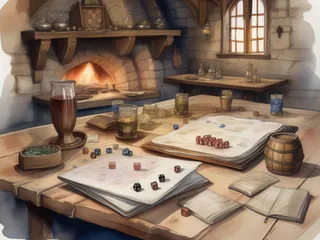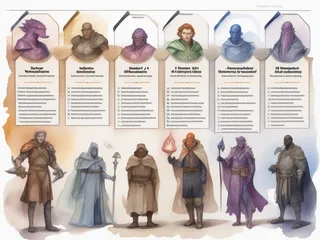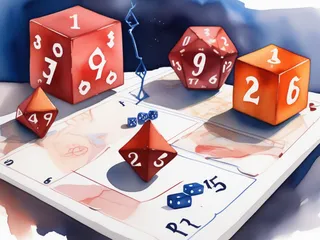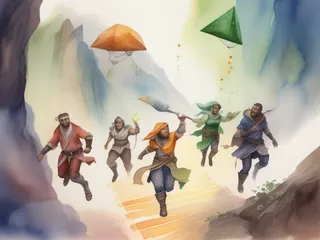You know that moment in sprint planning when everyone reveals their story point estimates simultaneously, and the numbers range from 2 to 13? That's not a planning failure—that's collaborative dice rolling at its finest. Just like a D&D party assessing whether they can take on a dragon, your development team is essentially asking "What are the odds we can pull this off?" The answer, as any seasoned dungeon crawler knows, depends on your party composition, available equipment, and whether anyone remembered to bring healing potions.
Session Zero: Setting Up the Campaign

Every great D&D campaign starts with Session Zero—that crucial planning meeting where everyone discusses expectations, sets boundaries, and figures out what kind of story they want to tell together. Sprint planning serves the exact same function for development teams, just with fewer character sheets and more acceptance criteria.
In Session Zero, the Dungeon Master describes the world, establishes the tone, and makes sure everyone understands the rules they're playing by. In sprint planning, the Product Owner paints the vision, clarifies business objectives, and ensures the team understands what success looks like. Both sessions answer the fundamental question: "What are we actually trying to accomplish here?"
The magic happens when everyone gets aligned on scope and constraints before diving into tactical decisions. You wouldn't start a D&D campaign without knowing if you're playing a gritty survival story or a heroic fantasy romp. Similarly, you shouldn't start a sprint without understanding whether you're optimizing for speed, quality, or learning.
The Pre-Game Ritual
Just like experienced D&D groups have their pre-session rituals—snacks, music, recap of last session—successful development teams establish their own sprint planning ceremonies. Some teams start with a quick team health check. Others review the previous sprint's velocity. The ritual matters less than the shared understanding it creates.
Character Sheets: Developer Skills as Stats

In D&D, your character sheet tells you everything about your capabilities. Strength 18? You're carrying the heavy equipment. Dexterity 8? Maybe stay away from the lockpicking. Development teams have their own version of character sheets, though we rarely make them explicit.
The Hidden Stats System
Every developer on your team has invisible stats that directly impact story point estimates:
Frontend Expertise (CHA): How well they handle user-facing features and the inevitable "can you make this pop more?" requests. High CHA developers navigate stakeholder feedback like diplomatic bards.
Backend Systems Knowledge (INT): Database optimization, API design, and the arcane arts of microservices architecture. These are your wizards—powerful, but they need time to prepare their spells.
DevOps Proficiency (WIS): Understanding of CI/CD, infrastructure, and deployment pipelines. The clerics of your party, keeping everyone alive and systems running.
Domain Experience (CON): How long they've worked in your specific business context. High CON means they can power through complex business logic without getting confused or burnt out.
Availability This Sprint (DEX): Vacation days, conference attendance, other project commitments. Even the most skilled developer can't contribute much if they're only available 10 hours this sprint.
Rolling Character Stats
The problem is we rarely acknowledge these stats explicitly during planning. We estimate stories as if every developer has identical capabilities, then wonder why our estimates vary wildly. It's like assuming every D&D character can pick locks equally well just because they all have hands.
Smart Scrum Masters learn to read their team's character sheets. They know Sarah's backend expertise makes API stories trivial for her but that frontend tasks require more effort. They understand that Mike's domain knowledge means he can navigate complex business logic quickly, but new team members might need support.
The Adventure Hooks: User Stories as Quest Objectives
"A mysterious stranger approaches you in the tavern with a quest..." Sound familiar? User stories serve the same narrative function in sprint planning. They're your adventure hooks—compelling objectives that give your team direction and purpose.
Writing Better Quest Hooks
Just like a good D&D quest hook, effective user stories need three elements:
Clear Motivation: Why does this matter to the user/character? "As a user, I want to reset my password" is functional but uninspiring. "As a frustrated user locked out of my account, I want to quickly reset my password so I can access my important data without calling support" tells a story worth caring about.
Obvious Stakes: What happens if this quest fails? The best D&D adventures have clear consequences for failure. Similarly, the best user stories explain what happens if this feature doesn't work properly.
Multiple Solution Paths: Great quest hooks allow creative problem-solving. User stories should focus on outcomes, not implementation details. "Defeat the dragon" is better than "Use a sword to attack the dragon exactly three times."
The Quest Board Approach
Some teams treat their product backlog like a tavern quest board—full of available adventures ranked by difficulty and reward. Developers can see what's available, understand the challenges, and volunteer for quests that match their interests and skills. This self-selection often leads to better estimates because people naturally gravitate toward challenges they understand.
Rolling for Initiative: Planning Poker as Collaborative Dice Rolling

Planning poker is essentially collaborative dice rolling with extra steps. Instead of rolling a d20 and hoping for the best, your team "rolls" story point estimates and discusses the results. The magic isn't in the numbers—it's in the conversation that happens when someone rolls a 2 and someone else rolls a 13 for the same story.
The Dice Mechanics of Estimation
Different estimation scales work like different dice in D&D:
Fibonacci (1, 2, 3, 5, 8, 13): Like using a d6 for simple checks and a d20 for complex ones. The bigger the number, the less precise your estimate becomes.
T-Shirt Sizes (XS, S, M, L, XL): Like advantage/disadvantage in D&D 5e—simpler, faster, but less granular.
Powers of 2 (1, 2, 4, 8, 16): Like doubling damage dice for critical hits—each step represents a significant complexity increase.
The Group Check Dynamic
When D&D parties make group checks, everyone rolls individually, but success depends on the collective result. Planning poker works the same way. Individual estimates matter, but the team's shared understanding is what determines success.
The most valuable estimates happen when team members have wildly different perspectives. That's not estimation failure—that's the system working. Just like when the rogue rolls a 20 for stealth while the paladin in full plate armor rolls a 3, diverse estimates reveal different assumptions about the challenge ahead.
Equipment Check: Technical Dependencies and Tooling
No experienced D&D party attempts a dragon fight without checking their equipment first. Similarly, no smart development team commits to a story without understanding their technical dependencies. Yet somehow, sprint after sprint, we discover mid-implementation that we need equipment we don't have.
The Adventuring Gear Inventory
Before tackling any significant story, your team should do an equipment check:
Weapons (Development Tools): Do we have the right IDEs, frameworks, and libraries? Is everyone running the same versions?
Armor (Infrastructure): Are our development, staging, and production environments ready? Do we have proper monitoring and logging?
Healing Potions (Support Systems): Are the right SMEs available? Do we have access to necessary third-party APIs? Are our testing frameworks working?
Rope and Grappling Hooks (Utilities): Database access, deployment scripts, debugging tools—the unglamorous stuff that saves your life when things go wrong.
The Missing Component Trap
Just like forgetting to bring rope to a dungeon crawl, missing technical dependencies can turn simple stories into epic quests. The 3-point "add a new field to the user profile" becomes a 13-point odyssey when you discover the user service is owned by another team, requires a database migration, and needs security review.
This is why experienced teams spend more time on dependency identification than on the actual estimation numbers. The story point is less important than understanding what could go wrong.
The Dungeon Master's Screen: What the Scrum Master Knows
Every DM has secrets behind their screen—monster stats, plot twists, and contingency plans the players can't see. Scrum Masters have their own version of hidden information that shapes how they guide sprint planning without directly influencing estimates.
The Hidden Information
Stakeholder Pressure: The PM mentioned this feature needs to be ready for a demo next week, but the team doesn't know that yet.
Technical Debt Bombs: There's a known issue in the authentication service that will probably explode during this sprint, but it hasn't surfaced yet.
Team Dynamics: Sarah and Mike worked poorly together on the last story involving the payment system, so pairing them again might add complexity.
External Dependencies: The third-party API integration looks straightforward, but you know from experience it always takes longer than expected.
The Art of Gentle Nudging
Good DMs guide without railroading. When the party is about to walk into an obvious trap, a skilled DM might describe the suspicious-looking floor tiles more dramatically or ask "Are you sure you want to step there?"
Good Scrum Masters use similar techniques during estimation:
- "That sounds reasonable. Have you considered the database migration aspect?"
- "The last time we worked on the notification system, we ran into some complexity around email deliverability. Worth thinking about."
- "Just checking—do we need design review for this story?"
The goal isn't to provide the answers, but to help the team ask the right questions.
Boss Battles: Epic Stories That Require the Whole Party

Every sprint has them—those epic-sized stories that make everyone shift uncomfortably in their chairs. These are your boss battles: complex features that require coordination, careful strategy, and the full attention of your development party.
Recognizing a Boss Battle
Boss battle stories share certain characteristics:
Multiple Systems: They touch authentication, payments, notifications, and the admin dashboard. Like fighting a hydra, attacking one part affects everything else.
Cross-Team Dependencies: Success requires coordination with other teams, external vendors, or legacy systems that haven't been touched since 2019.
Unknown Unknowns: The acceptance criteria seem clear, but everyone suspects there are hidden complexities waiting to emerge.
High Stakes: If this fails, it impacts customer experience, revenue, or regulatory compliance.
Boss Battle Strategy
You don't fight dragons with basic attacks. Similarly, epic stories need special treatment:
Reconnaissance Phase: Spend time understanding the challenge before committing. Spikes, proof-of-concepts, and architecture reviews are your scouting missions.
Party Composition: Make sure you have the right mix of skills. Boss battles often need that rare combination of domain expertise, technical depth, and stakeholder communication.
Preparation Time: Epic stories benefit from prep work—design documents, technical spikes, stakeholder alignment. Just like preparing spells and coordinating tactics before the big fight.
Contingency Planning: What happens if this takes longer than expected? What's the minimum viable version? How do we retreat gracefully if things go wrong?
Critical Failures: When Estimates Go Spectacularly Wrong

Every D&D player has rolled a natural 1 at the worst possible moment. Every development team has seen a "simple 2-point bug fix" turn into a week-long debugging odyssey that requires refactoring three different services. These critical failures aren't bugs in the system—they're features that force you to confront underlying problems you've been avoiding.
The Anatomy of a Critical Failure
Critical estimation failures usually follow predictable patterns:
The Rabbit Hole: What started as "just change this validation message" becomes "wait, why is user validation handled in seventeen different places?"
The Assumption Explosion: "This should be easy, it's just like the feature we built last month" meets the reality that last month's feature was built by someone who no longer works here and documented nothing.
The Integration Nightmare: Your code works perfectly in isolation, but integrating with the existing system reveals architectural decisions that seemed reasonable in 2018 but feel cursed today.
The Stakeholder Surprise: "Oh, by the way, this also needs to work with our legacy admin system that I forgot to mention."
Learning from Critical Failures
In D&D, rolling a 1 doesn't make you a bad player—it makes the story more interesting. Similarly, estimation failures aren't team failures—they're learning opportunities disguised as frustration.
The best teams treat critical failures like post-mortem analysis:
- What assumptions did we make that proved false?
- What information could we have gathered earlier?
- How do we update our "character sheets" (team knowledge) based on this experience?
Leveling Up: How Teams Improve Estimation Over Time

D&D characters start weak and become powerful through experience. Development teams follow the same progression—their estimation accuracy improves as they gain experience with their codebase, their domain, and each other.
Experience Points in Estimation
Teams gain estimation experience points through:
Domain Knowledge: Understanding the business context makes complexity more predictable. The team that's built five reporting features can estimate the sixth one more accurately.
Technical Familiarity: Knowing your codebase's quirks and patterns helps identify hidden complexity. "Oh, this touches the user service? That always takes longer than expected."
Team Dynamics: Understanding how your teammates work changes how you estimate collaborative efforts. Pairing Sarah with Mike on frontend stories works better than either working alone.
Historical Pattern Recognition: Tracking estimation accuracy over time reveals systematic biases. "We always underestimate stories involving the notification system by 50%."
The Level Progression
Level 1 Teams: Estimates vary wildly. Everything seems to take longer than expected. Stories frequently spill over between sprints.
Level 5 Teams: Estimates are reasonably consistent within a sprint. The team understands their velocity and can plan accordingly.
Level 10 Teams: The team can accurately estimate complexity across different types of work. They recognize patterns and can adjust estimates based on context.
Level 15 Teams: Estimation becomes a secondary concern because the team focuses on reducing uncertainty rather than predicting it. They break down epics effectively, identify dependencies early, and design systems for predictability.
The Expertise Trap
Paradoxically, very experienced teams sometimes become worse at estimation—not because they're less skilled, but because they optimize for different things. Just like high-level D&D parties stop worrying about basic encounters, senior teams might underestimate stories that would challenge junior developers.
This is why diverse teams often estimate more accurately than homogeneous ones. The senior developer thinks it's trivial, the junior developer sees hidden complexity, and the discussion reveals the truth somewhere in between.
Campaign Arcs: Release Planning as Multi-Session Adventures
Individual sprints are like single D&D sessions—focused, contained adventures that contribute to a larger story. Release planning is campaign arc design—weaving multiple sessions into a coherent narrative that builds toward a satisfying conclusion.
The Campaign Planning Session
Release planning meetings feel like campaign planning sessions. The Product Owner (lead DM) describes the overarching story they want to tell. The team discusses what's possible given their resources and timeline. Everyone contributes ideas about how different features could connect to create a compelling user experience.
Just like D&D campaigns need a mix of combat, exploration, and social encounters, releases need a balance of new features, bug fixes, and technical improvements. Too much of any one element creates an unbalanced experience.
Managing the Narrative Arc
Good campaign arcs have rhythm—periods of intense action followed by quieter character development moments. Good release planning creates similar rhythm in development work:
High-Intensity Sprints: Major feature launches that require all hands and careful coordination.
Consolidation Sprints: Bug fixes, technical debt reduction, and team skill development.
Exploration Sprints: Experimental features, proof-of-concepts, and research into new possibilities.
The Series Bible
D&D campaigns maintain continuity through detailed notes about characters, locations, and ongoing plot threads. Development teams need similar documentation—architectural decisions, user research insights, and technical debt tracking that help maintain consistency across multiple releases.
The Dice Don't Lie (But They Don't Tell the Whole Truth)

Story point estimates, like dice rolls, contain uncertainty by design. A 5-point story might take two days or two weeks, just like rolling 1d8+2 for damage could result in 3 points or 10 points. That variability isn't a flaw—it's an acknowledgment that software development, like dungeon crawling, involves unknown challenges that can only be discovered through exploration.
The goal isn't perfect prediction. The goal is shared understanding, risk awareness, and adaptive planning. When your team estimates a story at 8 points, they're not making a commitment—they're expressing collective uncertainty about complexity while agreeing to tackle the challenge together.
Embracing the Uncertainty
The best D&D sessions happen when players lean into uncertainty rather than trying to eliminate it. Similarly, the best sprints happen when teams use estimates as starting points for conversation rather than binding contracts.
Story points are communication tools disguised as measurement tools. They help teams discuss complexity, identify risks, and make collective decisions about what to attempt next. The numbers matter less than the shared understanding they create.
Key Takeaways
-
Estimation is collaborative uncertainty assessment, not individual prediction. Like group checks in D&D, success depends on the collective result.
-
Team "character sheets" matter more than story complexity. Understanding your team's skills, availability, and working relationships improves estimation accuracy.
-
Boss battle stories need special treatment. Epic-sized features require reconnaissance, preparation, and contingency planning.
-
Critical failures are learning opportunities. When estimates go wrong, focus on updating your team's knowledge rather than assigning blame.
-
Experience improves estimation accuracy over time, but diverse perspectives prevent expertise blind spots.
-
Release planning is campaign arc design—balancing different types of work to create sustainable development rhythm.
Ready to Roll
Next time your team gathers for sprint planning, remember you're not just estimating work—you're collaboratively assessing an adventure. Embrace the uncertainty, leverage your diverse skills, and remember that the best stories often emerge from the most unexpected dice rolls.
After all, if D&D has taught us anything, it's that the most memorable adventures happen when the dice don't go according to plan. The same principle applies to software development. Sometimes the best features emerge from what initially looked like estimation failures.
So grab your dice (planning poker cards), check your character sheets (team skills and availability), and get ready to tackle your next quest (user story). The dungeon (codebase) awaits, and your party (team) is ready for whatever complexity emerges.





